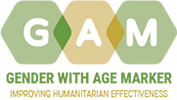What is the GAM?
Welcome to the IASC Gender with Age Marker.
If you’ve used the GAM before, you will notice some changes in 2021. To find out what’s new in the GAM, click here . People who completed the GAM in OCHA’s 2021 “Projects Module” have already used the revised GAM Design Questionnaire. It is still being edited and programmed; multiple languages and the monitoring section will be available soon.
Discussing and answering its questions with your colleagues greatly increases the likelihood that you will design a gender-responsive project.
How does it do that? (Click here to access further resources or scroll down to ‘why is it useful’).
Discussing and answering its questions during monitoring will help you identify what you are doing well, and where you may want to improve.
MOST IMPORTANTLY, results from GAM monitoring are a unique source of data on humanitarian inclusion and accountability, used in a variety of global reports. See here for more detail.
The GAM is NOT used to judge projects, or to decide whether they should be selected or funded.
It is called a “marker” because at the end of filling in the questionnaire, you will receive a “code.” This code does NOT reflect the quality of your proposal or monitoring report.
The code provides an indication of the consistency of your strategy or program with respect to the different gender and age groups identified for assistance.
Why is the GAM useful?
A reflective tool
The GAM was designed in response to requests from the field, for a tool that would help them understand how to do better gender equality programming. People knew they weren’t getting it right, but there was little practical advice on HOW projects could be improved.
The GAM offers 10 programming actions to improve attention to gender and age in projects and programs.
It is the process of discussing and answering the GAM questions that creates better projects. Ideally the GAM is used as a team planning or monitoring exercise. As supervisors, donors or managers, we do not need to know what “code” people received on their GAM; we only require evidence that they have completed the questionnaire.
The GAM provides topics and questions for project teams to discuss, reflect on, and decide if there are ways they can improve the project. It can be completed by a single monitoring officer, but users report it is most beneficial when project teams work together to complete the exercise. Nobody is going to apply the GAM to your project (this is very different from the old gender marker.)
You decide if you are happy with how gender and age concerns are reflected in your project. The GAM merely guides a reflective, learning process.
The only quantitative source of global data on gender & age
The GAM is accumulating a global data resource of how gender, age, and now disability are factored into humanitarian programmes worldwide.
Ensure effective assistance
Results from the GAM speak directly to Commitments from the Agenda for Humanity, including gender-responsive planning and programming; integration of SGBV prevention and response in humanitarian action; meaningful and effective engagement of affected people especially women and girls; improving transparency and accountability throughout the humanitarian program cycle.
Apply the GAM to ensure your organization and your country response plan are on track and delivering assistance effectively to women, girls, boys and men of all ages.
Impact beyond humanitarian work
Beyond humanitarian settings, the GAM is being used in development, peacebuilding and governance settings. Stories from our users are available here.
How to use the marker
Design: We recommend using the GAM during the design of your programme, to enable effectively planned programmes that consider age and gender throughout.
Monitoring: If your program or project been underway for three months or more, it’s time to use the GAM for monitoring.
Please remember to use Chrome or Firefox to open the GAM – it does not work in Internet Explorer.
Codes
Unlike other gender markers, this code does NOT reflect how well you have addressed gender differences in you program. It only reflects how consistently you have selected the intended genders, ages and people with disabilities. If you get a Code 2, 1, or 0, you may want to go back and check that your activities will reach the groups intended.
Reports
Once you complete the marker, you will be issued a reference number. To get a report of the information you entered, click here.

